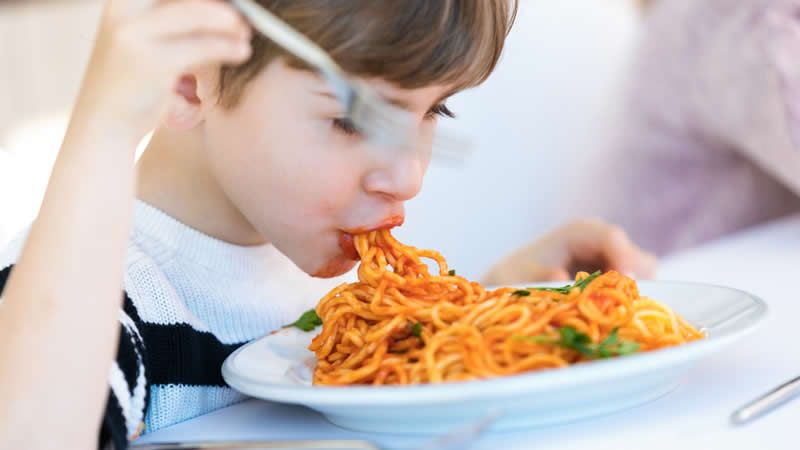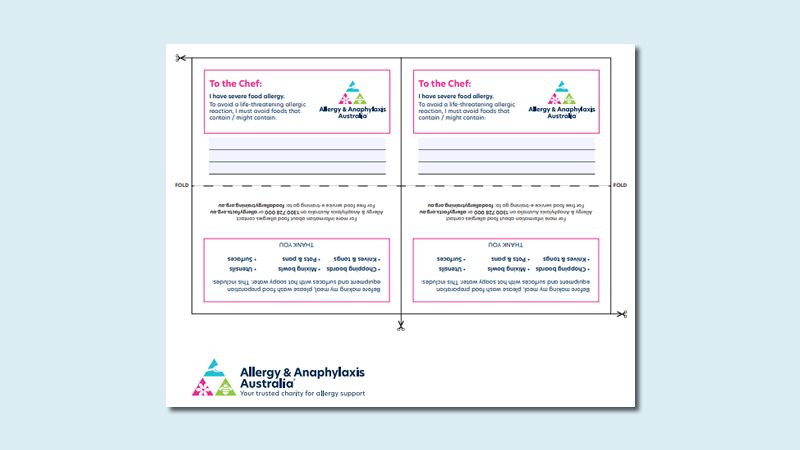Eating out with food allergies
When you eat away from home:
When you eat away from home:
-
Always carry your adrenaline (epinephrine) injector and ASCIA Action Plan with you.
-
Always tell food service staff about your food allergy when you order food or drinks.
-
Tell staff clearly that you have an allergy and which foods you are allergic to.
-
Do not just ask if something has milk, egg or peanut in it.
-
If you are not sure if the food or drink contains your allergen, do not eat it.
Drinking alcohol can affect the decisions you make when choosing food. If you are with people who are also drinking, they might not be able to give you the best help if you have an allergic reaction while you are with them.

Restaurants, cafes and other food outlets
When choosing a place to eat:
-
Look at the menu on the website before you go.
-
Avoid restaurants or food outlets that serve meals as a buffet.
-
There is a high risk of cross contamination from one food to another with buffet style meals.
-
-
Avoid cuisines that use your allergen a lot. For example, if you are allergic to peanut, tree nuts and crustaceans, avoid eating at Asian restaurants.
When you have chosen where to eat:
-
Call ahead and tell the restaurant staff about your food allergy. Ask what menu choices would be suitable for you.
-
Make a booking that is earlier than usual booking times so that the restaurant and kitchen staff are not as busy. For example, eat dinner at 5.30pm instead of 7.30pm.
-
Tell the restaurant about your food allergy when you book.
When you order your meal:
-
Tell restaurant staff about your food allergy when you order.
-
Ask if you can talk to the chef about ingredients used in the meal.
-
Ask if they have strategies to reduce the risk of cross contamination of allergens when they store, cook and serve food.
-
Do not ask for a guarantee. The risk of an allergic reaction can never be completely removed. But you want to know that they will do their best to provide you an appropriate meal.
-
Choose simple foods with not many ingredients. Meals with fewer ingredients can be better options for people with food allergy.
-
Ask about the food allergen content of your order again when your food and drink arrives.
-
Do not share anyone else’s meal because it may not be appropriate for your food allergy.
-
Use an Allergy & Anaphylaxis Australia Chef Card to communicate with serving and cooking staff about your allergy. The chef card can be downloaded for free from the Allergy & Anaphylaxis Australia shop in the link at the bottom of this page. The video explains how to use it.
How to use a chef card
Functions and events (weddings, work functions, conferences)
-
Respond to the invitation in writing and provide information about the foods you are allergic to.
-
Before the event, send an email to or call the function organiser reminding them of your food allergy. If possible, find out what food and drinks will be served at the function and how they plan to cater for your food allergy.
-
When you arrive, tell the event organiser about your food allergy and ask them again how they will be catering for your food allergy.
-
Don’t assume that the information has been communicated to the right staff.
-
-
When your meal is served, let the serving staff know about your food allergy and check they are giving you the right meal each time a food is placed in front of you.
More tips and resources for eating out:


